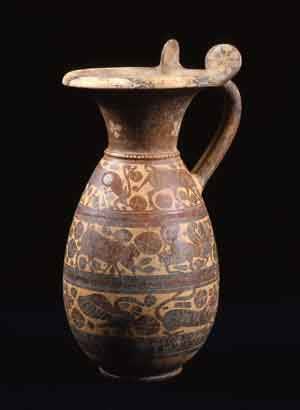Etrusco-Corinthian Terracotta Olpe, 580 BCE
Terracotta
height 31.4 cm
height 12 3/8 in
height 12 3/8 in
X.0530
Our knowledge about the Etruscan civilization is extremely limited. Our understanding of their language is still incomplete and most of the information that is known comes to us through the...
Our knowledge about the Etruscan civilization is extremely limited. Our understanding of their language is still incomplete and most of the information that is known comes to us through the Romans, their one-time subjects who grew to become their masters.
The Etruscans lived under a series of autonomous city-states spread out across northern and centra Italy. By the 3rd Century B.C., they would be absorbed into the burgeoning Roman Empire.
The evolution of Etruscan pottery follows the major artistic developments as they occurred throughout the Classical era. Before the 6th Century B.C., th island of Corinth, with their distinctive black-figure wares, dominated the lucrative pottery export trade. Corinthian wares were traded throughout the Mediterranean, and the vivid painting style became extraordinarily popular. Etruscan potters began t imitate the designs of their Corinthian counterpart to meet the demands of the local market.
Today, scholars have coined the ter “Etrusco-Corinthian” to describe such vessels,
believed to have mainly been created from 630 to 54 B.C. Etrusco-Corinthian vessels characteristic features traditional Greek shapes adorned with the black-figure style of painting that originated i Corinth. In the black-figure technique, the vas surface was covered with a diluted wash of clay. thicker solution of iron-rich clay formed the "glaze"
used to paint on figures in solid silhouette.
Intricate details were then incised onto the figures.
Finally, painted red and white highlights were adde before firing.
The decorative scheme is traditionally divided int bands filled with plants, and animals, both real and mythological. To these Corinthian characteristics,
the local Etruscan potters added motifs of local origin (including wild goats and human figures). Before the advents of Corinthian pottery (which was inspired by Eastern designs), Greek pottery was decorated primarily by scene of geometric motifs. This magnificent Etruscan olpe reveals why the Corinthian style was so popular. When contrasted t the cold, angled geometric patterns of the past, the presence of recognizable flora and fauna would have been a delight. The body of this vase has bee divided into three bands, each of which is filled wit various animals including a pig, a duck, a lion, and stag.
The Etruscans lived under a series of autonomous city-states spread out across northern and centra Italy. By the 3rd Century B.C., they would be absorbed into the burgeoning Roman Empire.
The evolution of Etruscan pottery follows the major artistic developments as they occurred throughout the Classical era. Before the 6th Century B.C., th island of Corinth, with their distinctive black-figure wares, dominated the lucrative pottery export trade. Corinthian wares were traded throughout the Mediterranean, and the vivid painting style became extraordinarily popular. Etruscan potters began t imitate the designs of their Corinthian counterpart to meet the demands of the local market.
Today, scholars have coined the ter “Etrusco-Corinthian” to describe such vessels,
believed to have mainly been created from 630 to 54 B.C. Etrusco-Corinthian vessels characteristic features traditional Greek shapes adorned with the black-figure style of painting that originated i Corinth. In the black-figure technique, the vas surface was covered with a diluted wash of clay. thicker solution of iron-rich clay formed the "glaze"
used to paint on figures in solid silhouette.
Intricate details were then incised onto the figures.
Finally, painted red and white highlights were adde before firing.
The decorative scheme is traditionally divided int bands filled with plants, and animals, both real and mythological. To these Corinthian characteristics,
the local Etruscan potters added motifs of local origin (including wild goats and human figures). Before the advents of Corinthian pottery (which was inspired by Eastern designs), Greek pottery was decorated primarily by scene of geometric motifs. This magnificent Etruscan olpe reveals why the Corinthian style was so popular. When contrasted t the cold, angled geometric patterns of the past, the presence of recognizable flora and fauna would have been a delight. The body of this vase has bee divided into three bands, each of which is filled wit various animals including a pig, a duck, a lion, and stag.



